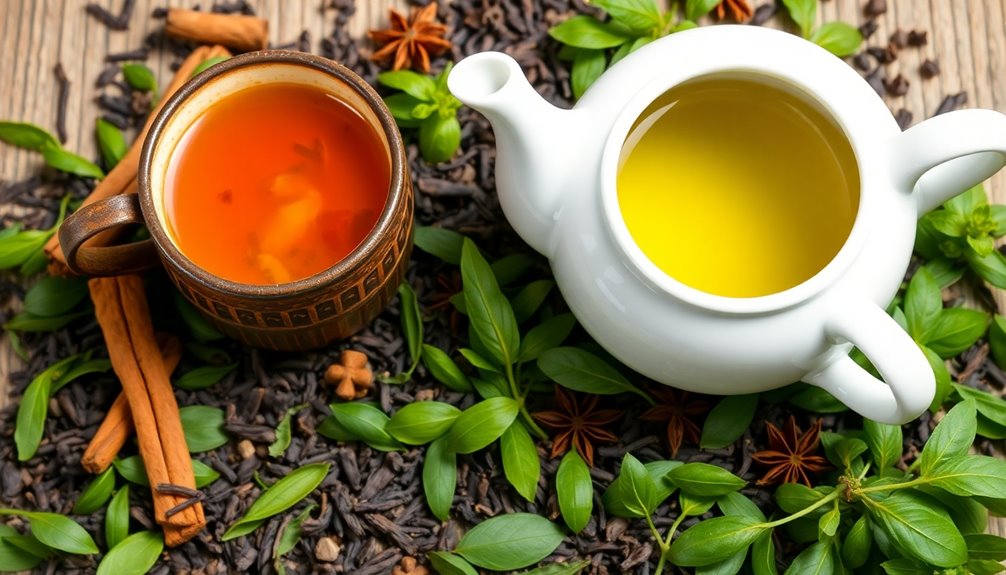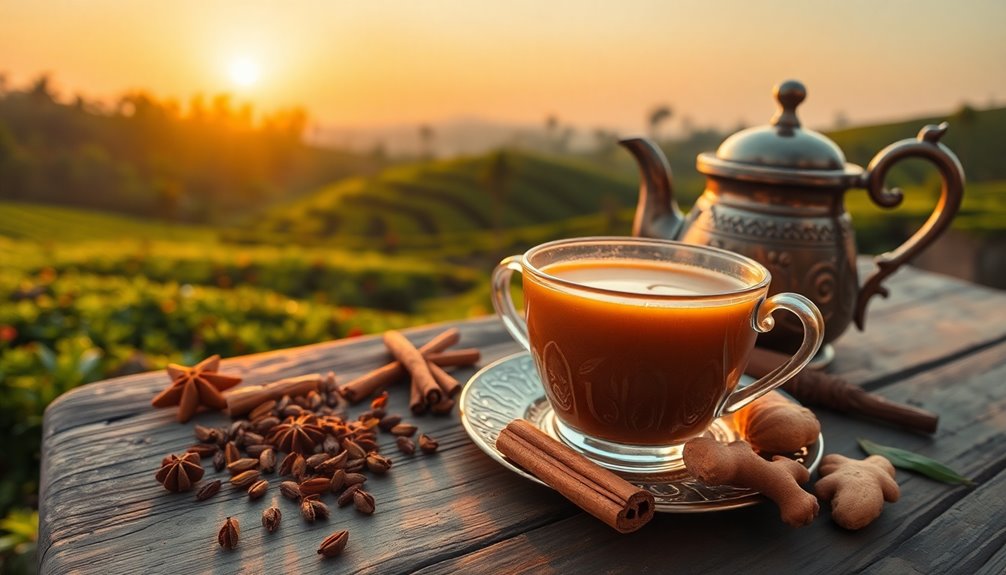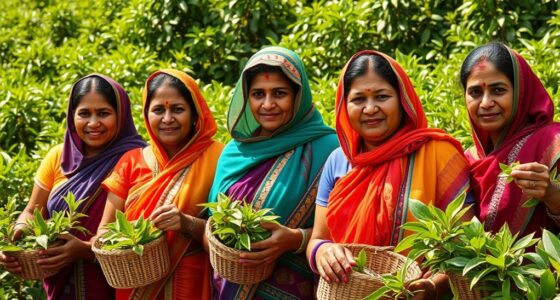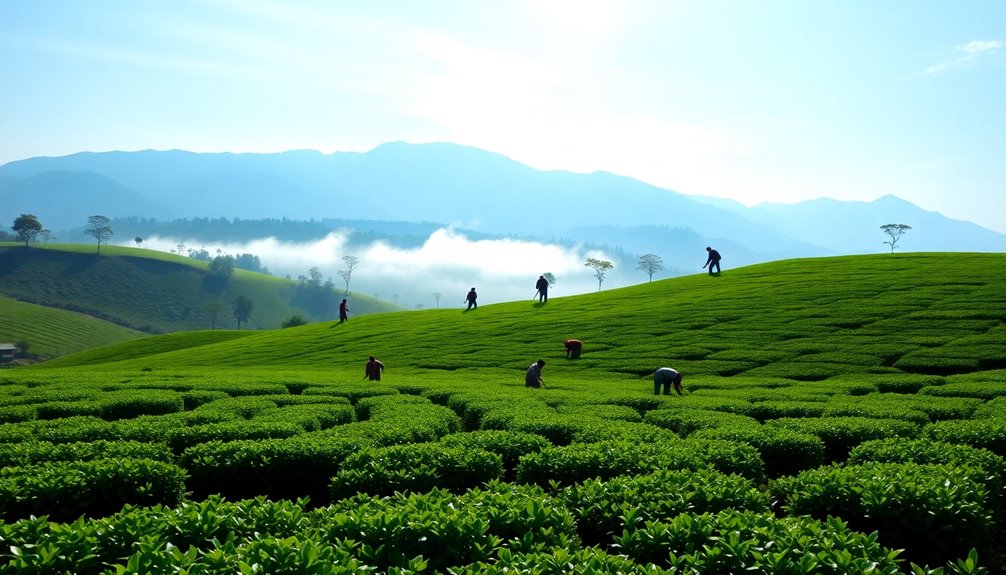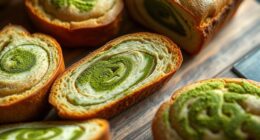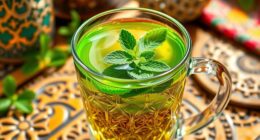When you compare Indian tea and Chinese tea, you're in for a flavorful adventure! Indian teas, like Assam and Darjeeling, are bold and malty, perfect for cozy gatherings. They often come with spices when brewed as chai. On the other hand, Chinese teas are softer and more delicate, with wonderful floral and nutty notes. Here's a quick recap:
- Indian Tea: Robust flavors, often spiced.
- Chinese Tea: Subtle, nuanced tastes.
Both have rich traditions and special ways of being enjoyed. So, grab your favorite cup, and you'll discover even more about these delightful beverages!
Key Takeaways
- Indian teas, particularly Assam, offer bold, robust flavors, while Chinese teas, like Keemun, are known for softer, nuanced tastes.
- The tropical climate of India influences its tea's strong character, contrasting with China's cooler climate that enhances delicate flavor profiles.
- Indian chai combines black tea with milk and spices, while Chinese teas are often prepared using the gong fu ceremony for purity and complexity.
- Assam teas are earthy and malty, whereas Darjeeling presents floral and fruity notes, showcasing India's diverse offerings compared to China's smooth, complex black teas.
- Cultural significance and preparation methods reflect each region's identity, highlighting the communal aspect of Indian chai versus the meticulous nature of Chinese tea ceremonies.
Introduction

Exploring the world of tea reveals a fascinating contrast between Indian and Chinese varieties. You'll find that both types of tea bring their own unique flavor profiles to the table.
Indian teas, like black and oolong, are known for their bold and robust flavors. This strong taste often comes from the tropical climate and monsoon conditions in India. On the other hand, Chinese teas, especially green and oolong, have softer and more nuanced flavors. The cooler climate allows these teas to develop their delicate taste.
You'll notice that the way these teas are processed plays a big role in their flavor. Indian tea is made to last through long shipping times, while Chinese tea focuses on traditional methods that enhance complexity.
It's also interesting how history shaped these flavors! Indian teas were made to please European tastes, resulting in straightforward flavors.
Both Indian and Chinese teas are part of rich tea cultures, featuring unique brewing methods. For instance, Indian chai is a cozy, spiced drink, while the Chinese gong fu tea ceremony highlights the art of tea making.
Cultural Significance of Tea

Tea isn't just a beverage; it carries deep cultural significance in both India and China.
In China, tea has been a treasured part of life for over 2,000 years. You might find yourself at a gong fu tea ceremony, where every step is done with care and respect for the tea-making process. It's all about enjoying the purity of the tea leaves!
On the other hand, Indian teas, especially chai, are a daily delight. They often include milk and spices, showcasing the cultural significance of hospitality and community. When you share a cup of chai, you're celebrating family bonds and warmth.
Both cultures see tea as a symbol of social status and tradition. Chinese tea reflects elegance and refinement, while Indian tea embodies joy and togetherness.
The British colonial era turned Indian tea into a global sensation, but it still holds close ties to local customs, just as Chinese tea does.
Tea Preparation Rituals Differ Greatly
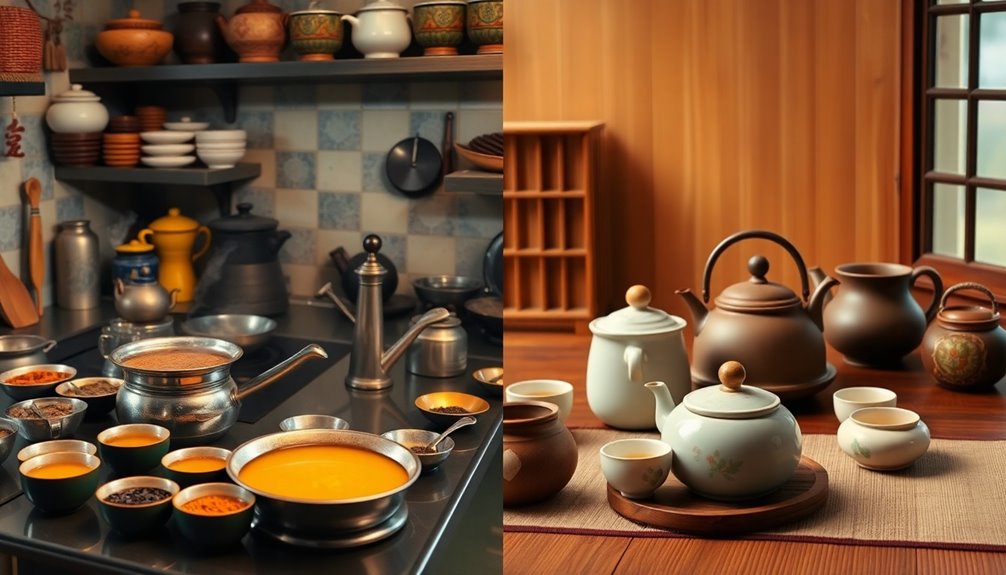
In the world of tea, preparation rituals reveal distinct cultural identities. When you think of Chinese teas, picture the elegant gong fu tea ceremony. This traditional method focuses on purity and allows you to steep the tea multiple times. Each short steep, lasting just 10-30 seconds, brings out the tea's complex flavors, making it a delightful experience!
On the other hand, Indian tea preparation is all about chai. You'll often find black tea brewed with milk, spices, and sugar, creating a rich, sweet beverage that warms the heart. It's a drink enjoyed throughout the day, perfect for sharing with friends and family.
Here's a quick comparison:
- Chinese Tea Preparation:
- Uses a higher quantity of leaves
- Steeped for shorter times
- No additives, savoring natural flavors
- Indian Tea Preparation:
- Typically brewed with milk and spices
- Steeped for 2-3 minutes
- Customizable with sweeteners for that comforting taste
Whether you prefer the artful brewing of Chinese teas or the flavorful, cozy vibe of Indian tea, each ritual brings joy to tea lovers everywhere!
Regional Flavor Profiles
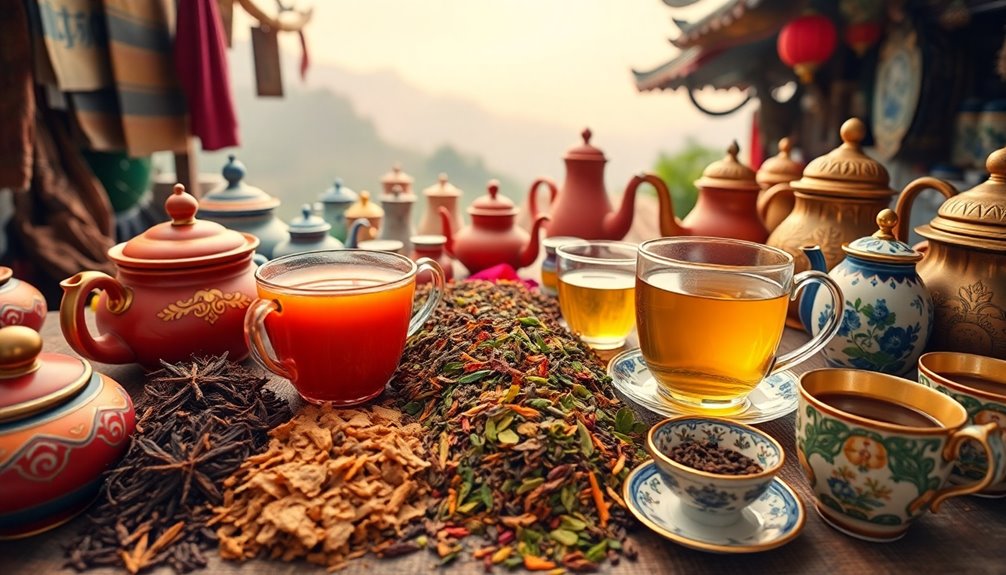
Cultural rituals around tea preparation set the stage for the diverse flavor profiles found across regions.
When you dive into Indian black teas, you're in for a treat! Teas from Assam bring robust, earthy, and malty flavors, perfect for a hearty cup. On the other hand, Darjeeling teas surprise you with their delicate floral and fruity characteristics. They change with the seasons—first flush teas taste green and grassy, while the second flush is all about those fruity and floral notes. The importance of proper sizing in brewing techniques can also affect the flavor extraction, enhancing your overall experience.
Now, let's travel to China! Chinese black teas, like Keemun, offer a smooth and complex flavor profile. You'll be delighted by nutty and chocolaty undertones, along with a hint of smoky aroma.
The terroir plays a big part, too. India's tropical climate gives its teas boldness, while China's temperate climate fosters nuanced flavors that are less bitter. Additionally, flower teas from both regions contain antioxidants, contributing to their health benefits and enhancing the overall experience.
When you brew these teas, remember that Indian black teas often shine with milk and sugar, enhancing their boldness. In contrast, you'll want to enjoy Chinese black teas plain to savor their intricate subtleties.
Each cup tells a story, inviting you to experience the unique flavors of each region!
Cultural Appropriation Debates
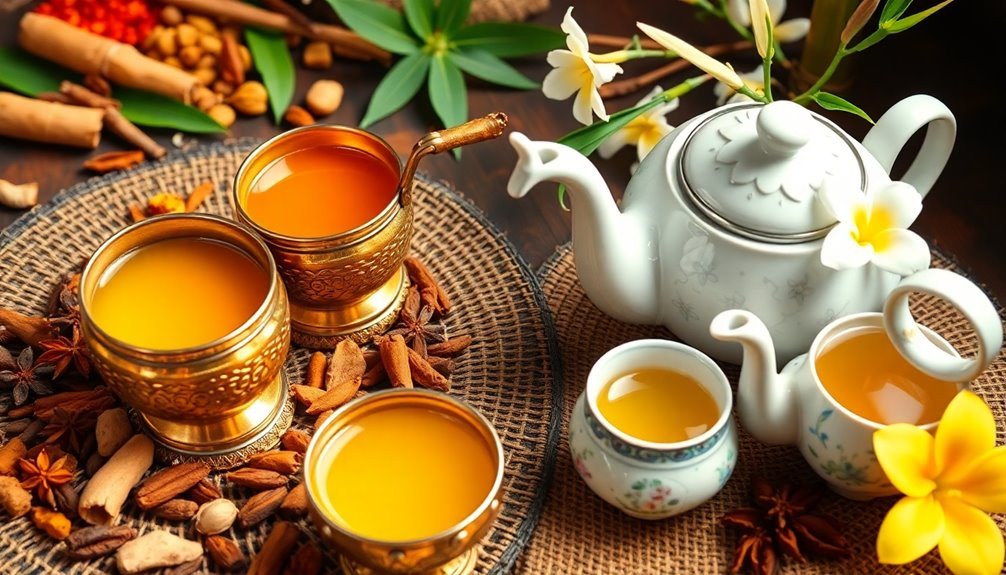
Debates about cultural appropriation in the tea world often ignite passionate discussions among enthusiasts and scholars alike.
When it comes to Indian tea and Chinese tea, many people have strong feelings about how these traditions are shared and celebrated. Critics often worry that when Western cultures mass-produce chai or other Indian teas, they lose their rich history and cultural significance. Instead of being seen as special drinks, they might just become trendy beverages.
On the flip side, some folks believe that sharing these teas helps everyone appreciate and respect Indian and Chinese cultures. They argue that this exchange promotes diversity in tea drinking, which can be a wonderful thing!
However, we must also consider the impact of colonialism, especially in India's tea industry, where British practices changed traditional tea growing and drinking.
As you enjoy your favorite cup of tea, whether it's Indian or Chinese, remember the importance of understanding where it comes from. Engaging in conversations about cultural appropriation can help ensure that these beautiful traditions are honored and enjoyed by everyone, creating a sense of community and shared joy!
Practical Applications

Understanding the practical applications of tea flavor differences can enhance your tea-drinking experience significantly. When you choose between Indian black teas and Chinese teas, think about how each one fits into your day.
- Indian Black Teas: These bold brews are perfect for a cozy morning. You can add milk and sugar to boost their robust flavor profiles. Steep them for just 2-3 minutes, and you'll have a tasty cup ready to energize your day!
- Chinese Teas: Known for their smooth, nutty flavors, these teas shine when enjoyed plain. Their complexity makes them great for quiet afternoons or special gatherings.
Try using multiple short steeps to really bring out those subtle notes!
– Flavor Profiles: Remember, Indian teas are straightforward and strong, while Chinese teas offer a delightful dance of flavors.
Frequently Asked Questions
What Does Indian Tea Taste Like?
Indian tea tastes bold and robust, with earthy and malty notes. You'll notice unique flavors in varieties like Assam's strong profile and Darjeeling's delicate floral hints, making each sip a delightful experience.
What Does Chinese Tea Taste Like?
Chinese tea offers a delicate balance of flavors, from light and aromatic green teas to complex, fruity oolongs. You'll discover nutty undertones in black teas, creating a rich and smooth experience that tantalizes your palate.
Which Tea Does the Author Prefer China Tea or Indian Tea?
You might prefer Chinese tea for its smoothness and intricate flavors, but you also appreciate Indian tea's boldness, especially when enjoyed with milk and spices. Ultimately, your choice reflects a balance between both unique qualities.
How Is Indian Tea Different?
Indian tea's different because it offers bold, robust flavors that thrive with milk and spices. You'll find its strong characteristics ideal for chai, contrasting with the lighter, more delicate flavors typical of other tea varieties.
Conclusion
In conclusion, both Indian and Chinese teas offer unique flavors and stories that can brighten your day! Whether you enjoy a spicy chai or a delicate green tea, each sip brings joy and warmth. Tea isn't just a drink; it's a celebration of culture and friendship. So gather your family, brew a pot, and explore these delightful flavors together. Let the world of tea fill your home with happiness and laughter—it's a wonderful adventure waiting for you!

